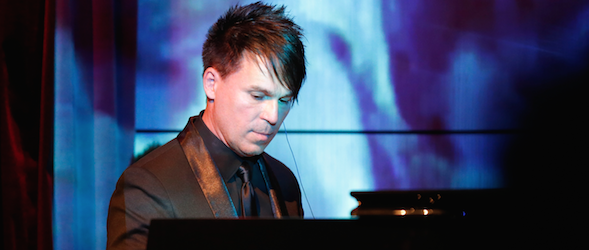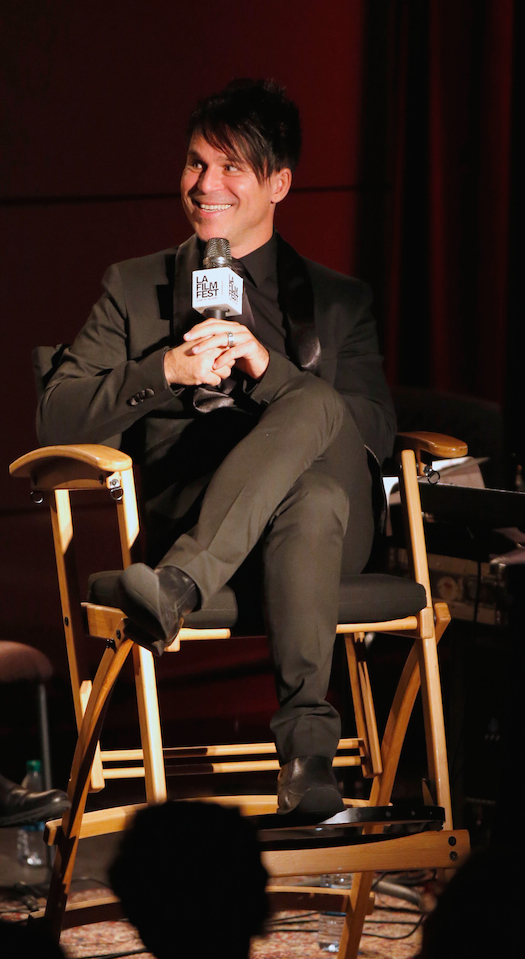How BT Went from Toddler Prodigy to EDM Guru to Film Composer (and lived to tell the tale)

It would be impossible to encapsulate the head-spinning achievements of BT in the span of one film festival conversation or in a brief blog. I’ll spare myself the agony of the attempt by taking two shortcuts: 1) a timeline skimming the surface of his path from 3-year-old piano-obsessed prodigy to being the godfather of trance—(bumper stickers with his name on them!)—and the acclaimed film composer he is today. And 2) digressions that represent just a few of the true—and truly inspiring—stories told last night at the LA Film Fest event, BT: Electronica in Film, moderated by BMI VP of Film & TV, Doreen Ringer-Ross. Or, as BT calls her: “the first person in LA who let me into her office.”
First, a warning and a drinking game idea: Those prone to feelings of under-achievement should stop reading this—not kidding. And, if you ever get to hear BT talk on his craft and his career, do a shot every time he calls himself “a nerdy kid.“
- A 3-year-old BT is so obsessed with the piano. His hands are too small. He persists, and he soon begins performing classical recitals. “At 5?” asks Doreen. “Around then.”
- At age 8, he is accepted as a classical pianist into the prestigious Washington Conservatory of Music, where he studies composition and theory, a “formative experience”—thanks largely to one visionary teacher.
Tale #1: The Visionary Teacher
There are the traditional ‘three B’s’ (Beethoven, Brahms, Bach) young musicians typically are exposed to by their instructors, but this teacher turned him onto a different world, including another ‘B’—Bartok. “He [also] introduced me to 12 tone row and composers like Anton Reicha—as an 8-year-old.” For a child accustomed to having his knuckles rapped by his piano teacher for improvising, the rogue approach marked a turning point. “[The teacher] saw in me immediately this incredible passion for music and the way it expressed in me was as a composer, and not as an instrumentalist.”
- “My burning desire to write music for films, I can trace to a single moment.” The summer he was 13, he rode his bike to a matinee and watched Blade Runner. “Coolest movie I’ve ever seen in my life. And it was the first time it connected for me, how much music can augment the experience of film,” he said. “I’m still trying to collect all Vangelis’s synths.”
- He pioneers the now-ubiquitous stutter edit, which he begins experimenting with “as a kid,” while working as a tape op at a recording studio. (He later will be credited with inventing other ground-breaking techniques, granular synthesis and nano-correcting.)
Tale #2: The Eureka Moment
“It was this amazing place. They had all kinds of reel-to-reel tape machines. I was a 14-year-old kid pouring coffee and tea I’d be pouring coffee and tea during the day, and they’d say, just lock up for us at night. And I’d go, ‘yeah, lock up in about six hours.'” Using a grease pencil and a razor blade, he set about to see what happens when… He’d record on the drum machines and synths to half inch tape, figure out by tempo how long at 15 inches per second or 30 inches per second “the bar was, say, eight feet, and I’d sit there with my little grease pencil and razor blade and I would go ‘er-er, er-er,’ on the downbeat at the beginning and end, and what happens if you do this at the beginning and the end. [This presumably is the sound of marking and splicing.] “I started getting this idea where instead of musique concrete, where it’s like, hey, here’s a doorbell sound, here’s a dolphin,… what happens if you take these things that are musical events out of context and re-contextualize them as a grid?” (Bonus fun fact for music nerds: Stutter edits can go beyond 2,048th notes.)
- At 15, BK auditions for the Berklee College of Music, where he discovered, much to his delight that in jazz, you are allowed and encouraged to improvise. For fun, he spends his free time taking apart synthesizers, teaching classmates how to program on a PC and taking apart a TB 303 to make it oscillate.
- After dropping out of Berklee at 18, and moving to LA to pursue his dream of getting a record deal, BT tries to get work by calling every listing in the Yellow Pages (remember those?) under “music.” The tactic fails.

Tale #3: Ignore the Assholes
Not long after moving to Los Angeles, BT ended up meeting people who knew people and one day he found himself in the office of a “gruff” A&R guy, who shall remain nameless. (You know who you are.) BT handed him a cassette and the guy popped it in a machine. “He listens to like 15 seconds, fast forwards, listens to about 15 seconds of the next song, takes it out, says basically, ‘This is crap. You’re never going to make it in music. You’re a good looking kid, try to get on an Aaron Spelling show.’ I’m like 19, 20 maybe, I walked around in a bathrobe for a month, going ‘Oh my god, this didn’t work out.’ Years and years later, I was at a premiere. I was on the red carpet, doing interviews and this guy comes up to me and he goes, ‘I followed your work since the beginning of your career. Your work is thoughtful and fantastic and I love it. I love what you’re doing. It’s really nice to meet you.’ I shook his hand. And it was the same guy.” Moral of the story: Don’t be an asshole to young artists. “Not only is music a hard pursuit in terms of a career path,” BT said. “But it’s a hard thing to carry emotionally, to really be authentic and to make music.”
- In 1999, he writes his first film score, Go. Director Doug Liman and his dog show up at BT’s house in Maryland. “This movie’s about rave culture,” Liman tells him. “We want someone who really intimately understands electronic music culture to compose the score for it.”
- The following year, he fulfills a life-long dream of writing music for film using an orchestra by working on Under Suspicion (Morgan Freeman and Gene Hackman) for free. “I took what would have been my fee,” he says, “and I spent it on a string ensemble.”
Tale #4: On Sometimes Flummoxing Purists and Producers
While composing for The Fast and the Furious in 2001, for a piece that plays over the scene at the end where Vin Diesel jumps the railroad tracks, BT presented the musicians with a piece of music with no notes, but rather an explanation in text: ‘Violins start at a random note between F and A sharp. Violas start at a random note between C and F. Everybody grab quarter tones pianissimo, very sharp and crescendo over 32 bars and swell into open fifths, but I want everyone to whisper, pianissimo and when you get to the biggest moment in it, triple forte, I want everyone to exhale.’ “Our producer absolutely freaked out, and said, ‘What is this junk!? There’s no notes on the page!!!!'” yelling at Rob Cohen, our director, and Rob said, ‘This is important, let him try this.’” BT heard that for months afterwards, the orchestral musicians’ water cooler talk was about this “insane” thing they got to try. (For the same film, he procured car wreckage from the shoot and invites orchestral percussionists to play it.)
- In 2003, he writes a song, Somnambulist (Simply Being Loved), with 6,178 vocal edits. The Guinness Book of World Records calls. He gets in.
- That same year, moved to tears by the power of the story—he sobbed so hard reading the script for Monster—he had to hide in the bathroom on a plane—BT agrees to score “A pretty crazy, emotional process for all of us.”
Tale #5: Steve Perry, the Intern
BT got to know Steve Perry after Charlize Theron convinced the Journey frontman to let them use Don’t Stop Believing in Monster. Perry started hanging out at the studio, peppering everyone with questions during post. Perry kept showing up, bringing coffee and questions. “It became a joke at my studio that Steve Perry was our new intern. He kept showing up, like ‘Hey guys, what are we doin’ today?’” One day, amused and inspired by Perry’s insatiable curiosity, BT half jokingly mentioned to producer Brad Wyman that a rock star going back to college would make a funny show. Brad took it to CAA, who took it seriously, and asked BT to recruit the rock star. After Perry turned it down, BT called his friend Tommy Lee, who had one question: “Can I stay in the chicks’ dorm?” Pitch meetings ensued, including very first one in which Lee pulled his pants down to prove to the NBC suits that he, fittingly, has a peacock tattoo on his thigh.
- BT scores Tommy Lee Goes to College. It aired in 2005 on NBC.
- The following year, he releases This Binary Universe, an ode to his then-1-year-old daughter Kaia. Keyboard magazine writes: “In a hundred years, it could well be studied as the first major electronic work of the new millennium.“
- He launches his software company Sonik Architects in 2009 to create a line of sound design tools for the studio and another line for live performances.
- In 2010, his sixth album, These Hopeful Machines is nominated for a Grammy.
- In April 2015, he blows the roof off Miami Music Week with Electronic Opus, an album and concert experience featuring BT’s signature EDM hits re-imagined with a full orchestra. Critics flip. The audience reportedly “rotated between standing ovation, full on dance party and jaw-dropped awe”.
- BT’s upcoming film projects are Dark Places, starring Charlize Theron, and Solace, starring Colin Farrell and Anthony Hopkins.
Post script #1: When the Pot Calls the Kettle Black
Amazed that the legendary actor composed a piece of music for Solace (and is a painter as well), BT thinks Hopkins is an over-achiever.
Pamela Miller / Website & Grants Manager